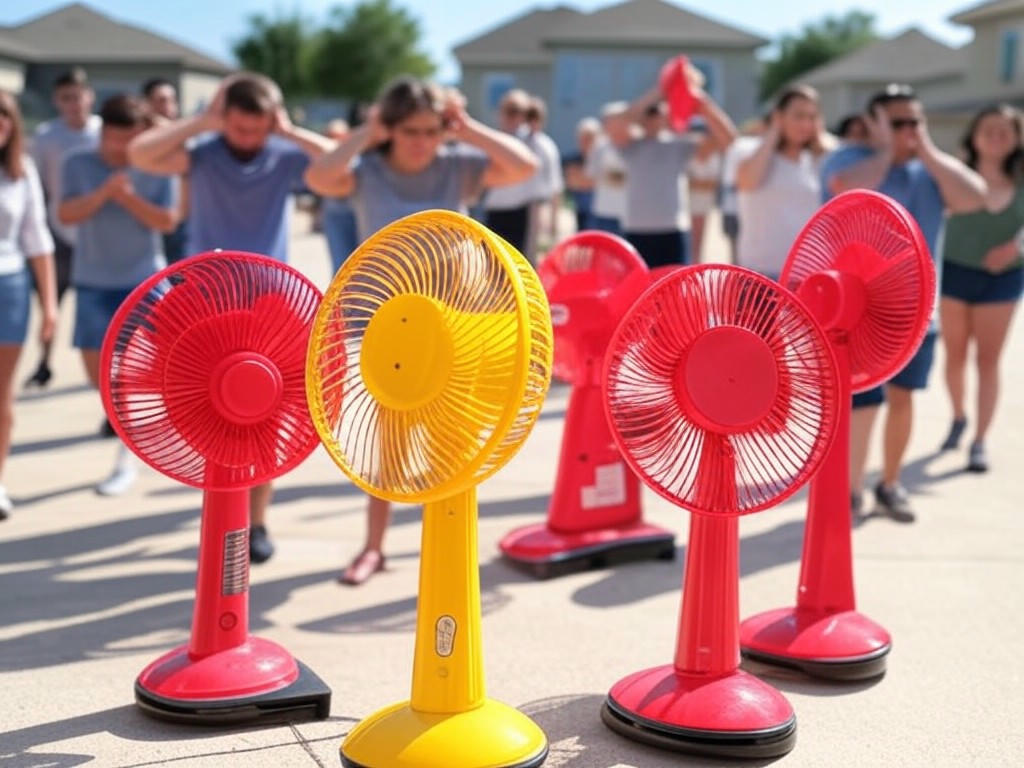
Crypto Noise Pollution Disrupts US Residents Amid Trump’s Crypto Push
Crypto Noise Pollution Disrupts US Residents Amid Trump’s Crypto Push
Texas Town Becomes Ground Zero for Crypto Noise Pollution Complaints
Imagine living next to a relentless symphony of industrial fans, where the noise never fades. That’s the reality for residents in Granbury, Texas, thanks to a massive 300-megawatt Bitcoin mine run by Marathon Digital. With over 20,000 computers humming day and night, crypto noise pollution has turned this quiet town into a hotspot of discontent, with sound levels often spiking above 85 decibels—think of it like a blender cranked to full power right outside your window. As President Trump’s push for cryptocurrency gains momentum, including plans for a Crypto Strategic Reserve, communities like Granbury are paying the price with disrupted lives and mounting health concerns.
Health Crisis Stemming from Crypto Noise Pollution
This isn’t just about annoyance; crypto noise pollution is sparking real health issues. Multiple locals have reported persistent problems, such as tinnitus and noticeable hearing loss, which could become permanent if exposure continues. Beyond that, neurological effects are emerging, with residents dealing with chronic migraines and episodes of vertigo that make everyday activities a challenge. Wildlife in the area isn’t spared either—animals are being displaced, and there’s growing evidence of increased air and water pollution linked to these operations, raising questions about the broader environmental footprint of Bitcoin mining.
What if your home environment constantly threatened your well-being? In Granbury, families are facing exactly that, highlighting how crypto noise pollution intertwines with daily health struggles. Actionable tip: If you’re near a mining facility, consider documenting noise levels with a decibel app to build a case for local authorities.
The Science Behind Crypto Noise Pollution from Mining
At the heart of crypto noise pollution lies the intense demands of Bitcoin mining, where powerful ASIC computers generate massive heat that requires constant cooling. Most mines rely on methods that, while effective for operations, create a racket that’s hard to ignore. For instance, traditional air cooling systems can produce noise levels between 50 and 75 decibels, which might seem manageable at first but adds up over time.
| Cooling Method | Noise Level | Example |
|---|---|---|
| Air Cooling | 50-75 dB | Granbury’s initial operations |
| Liquid Immersion | 30-40 dB | Marathon’s upgrade attempts |
Marathon Digital has tried fixes like selective fan shutdowns and switching to liquid cooling, but residents say it’s not enough—the noise persists, sometimes even worsening due to echoes and vibrations. Have you ever wondered how something as digital as cryptocurrency could have such a tangible, physical impact? It’s a reminder that behind the screens, crypto noise pollution is reshaping neighborhoods in unexpected ways.
Legal Battles Over Crypto Noise Pollution Escalate
Frustration in Granbury boiled over in October 2024 when Earthjustice attorneys stepped in, filing a lawsuit against Marathon Digital. The core argument? That the mine’s operations violate nuisance laws by causing “unreasonable discomfort” to more than 25 nearby households, not to mention leading to property devaluation in a local mobile home community.
Key Legal Challenges in Crypto Noise Pollution Cases
- Nuisance law violations: The constant din from crypto noise pollution is more than a nuisance—it’s disrupting sleep, work, and mental health for families living nearby.
- Regulatory gaps: Texas doesn’t have tailored rules for crypto noise pollution, leaving residents to navigate a patchwork of general environmental laws that often fall short.
- Property devaluation: Homes adjacent to the mine are seeing their values drop, forcing owners into tough financial decisions amid this growing crisis.
This legal fight isn’t isolated; it’s part of a larger pattern where communities are pushing back against unchecked crypto operations. A relatable example: Think about how highway noise can lower home prices—now amplify that with 24/7 mining sounds.
National Pattern of Communities as Crypto Noise Pollution Sacrifice Zones
Granbury isn’t alone in this struggle; it’s part of a nationwide trend where towns become “sacrifice zones” for the crypto boom. In Adel, Georgia, for instance, residents have gone to extremes, installing up to 11 layers of insulation in their bedrooms just to mute the incessant noise from nearby mines.
- They’ve recorded indoor noise levels over 70 decibels, which is like having a vacuum running non-stop in your living room.
- Local officials have often dismissed complaints, leaving people feeling powerless and isolated.
This pattern raises a key question: As Trump’s crypto policies encourage more mining, how many more communities will face crypto noise pollution before regulations catch up? It’s a human story of resilience amid industrial expansion.
Political Crosscurrents and Crypto Noise Pollution Debates
While Senator Ted Cruz champions Texas as the “crypto universe,” the reality on the ground is more complicated, with crypto noise pollution clashing against grid stability and public health. Trump’s proposals, like a national Crypto Strategic Reserve, add fuel to the fire, prioritizing industry growth over resident well-being.
Conflicting Priorities in the Crypto Noise Pollution Arena
- Grid stability concerns: These mines can strain power supplies, potentially causing failures during extreme weather, as seen in Texas’ 2021 winter storms.
- Tax revenue versus health: Local governments weigh the economic benefits against the human cost, like in fights over tax abatements for energy companies.
- Federal momentum: With Trump’s influence, crypto noise pollution might intensify if federal support overrides local protections.
What’s your take on balancing innovation with community health? This debate shows how crypto noise pollution is becoming a flashpoint in broader political discussions.
Resident Voices Amplify the Human Toll of Crypto Noise Pollution
Hear directly from those affected: Danny Lakey, a Granbury resident, shared, “It’s like living inside a jet engine. We can’t open windows, can’t enjoy our porches. The vibration never stops.” Stories like his paint a vivid picture of sleep deprivation and abandoned homes due to the unending “electronic thunder” from mining operations.
Families are forced to adapt, but at what cost? A hypothetical scenario: Picture trying to host a family dinner with constant background roar—it’s not just inconvenient; it erodes quality of life and community bonds.
Global Perspective: Addressing Crypto Noise Pollution Worldwide
Unlike Texas’s hands-off approach, other countries are tackling crypto noise pollution with stricter measures. In Iceland, for example, noise limits are set at 45 decibels during the day, integrated with geothermal energy to minimize disturbances in residential areas.
| Country | Noise Limit | Enforcement |
|---|---|---|
| Iceland | 45 dB daytime | Geothermal integration |
| Norway | 40 dB residential | Arctic server farms |
These examples show that effective regulations can coexist with crypto growth. Could adopting similar standards help US residents? It’s worth considering as crypto noise pollution spreads globally.
The Neuroscience of Chronic Crypto Noise Pollution Exposure
Prolonged exposure to noise levels above 70 decibels, common near mining sites, doesn’t just irritate—it alters the brain. Studies indicate elevated cortisol levels, which can lead to stress-related issues, alongside impaired cognitive function and heightened cardiovascular risks.
- Elevated cortisol levels: This stress hormone can affect sleep and mood over time.
- Impaired cognitive function: Constant noise makes it harder to concentrate or relax.
- Increased cardiovascular risk: Long-term exposure may contribute to heart problems, as research from reliable sources suggests.
If you’re in a high-noise area, a simple strategy is to use white noise machines or seek community advocacy groups for support—small steps can make a difference against crypto noise pollution.
Energy Grid Realities and Crypto Noise Pollution in Texas
Texas’s ERCOT grid is under strain from crypto mines, which consume enough power for over 300,000 homes and often get priority during crises like the 2022 winter storms. These operations also secure below-market energy rates, exacerbating inequalities and contributing to crypto noise pollution issues.
- They siphon resources that could serve everyday needs, highlighting the trade-offs in energy policy.
- As demand grows with Trump’s crypto push, so does the potential for more noise and instability.
This intersection of energy and noise pollution prompts a bigger question: How can we ensure sustainable crypto development without sacrificing community health?
The Path Forward Amid Crypto Noise Pollution Challenges
While solutions like soundproofing homes or building onsite barriers are on the table, they’re not perfect—some modifications cost over $10,000 with limited results, and certain barriers have even amplified noise through reverberation. Integrating renewables might offer long-term hope, but it’s unproven at scale for reducing crypto noise pollution effectively.
Mitigation Strategies for Crypto Noise Pollution
- Soundproofing: Upgrades can help, but they often fall short against persistent noise.
- Onsite barriers: What works in theory doesn’t always in practice, as seen in Granbury.
- Renewable integration: Exploring solar or wind could cut noise, but it requires innovative approaches.
As cryptocurrency remains a 2024 election issue, communities are calling for proactive measures to prevent more “energy sacrifice zones.” What steps can you take? Start by engaging with local reps or joining advocacy efforts to push for better regulations.
Final Thoughts and Call to Action
In wrapping up, crypto noise pollution is more than a side effect—it’s a urgent wake-up call as Trump’s crypto agenda accelerates. From health risks to legal fights, affected residents deserve solutions that prioritize their well-being. I encourage you to share your experiences in the comments below, spread this article to raise awareness, or explore related topics on our site for more insights. Together, we can drive change—your voice matters in this evolving debate.
References
- “A Bitcoin Mine in Texas is Killing Us Slowly, Local Residents Say.” The Real News, therealnews.com.
- “Granbury Residents Sue Local Bitcoin Mine Over Health-Threatening Noise Pollution.” Earthjustice, earthjustice.org.
- “Why Is Crypto Mining Noisy?” CoinLedger, coinledger.io.
- “Working People in Texas Face Bitcoin ‘Sacrifice Zone’.” In These Times, inthesetimes.com.
- “Texas Bitcoin Mine Noise and Power Grid Issues.” Texas Tribune, texastribune.org.
- “How Will Bitcoin Price React to Trump’s Latest Crypto Speech?” FXStreet, fxstreet.com.
- “Proof of Problems: Bitcoin Mining’s Pollution Toll in US Communities.” Environmental Working Group, ewg.org.
- “Defeating Coercive Information Operations.” Johns Hopkins APL, jhuapl.edu.
crypto noise pollution, Bitcoin mining health effects, Texas Bitcoin mine lawsuit, cryptocurrency environmental impact, Trump crypto policy, crypto mining noise regulations, health risks from crypto, US crypto communities, Bitcoin energy concerns, crypto pollution solutions







